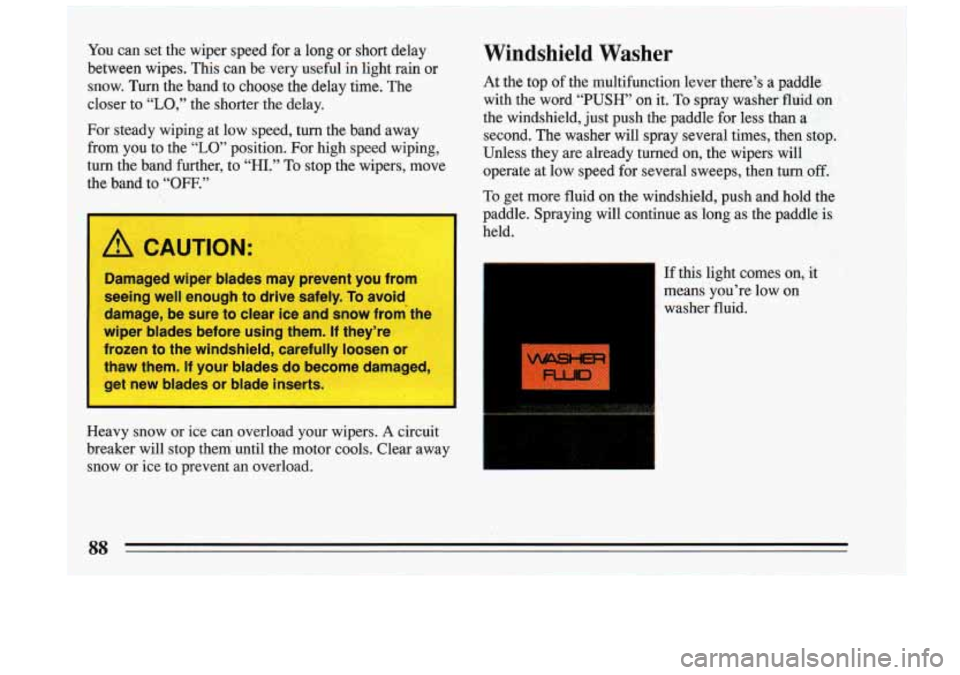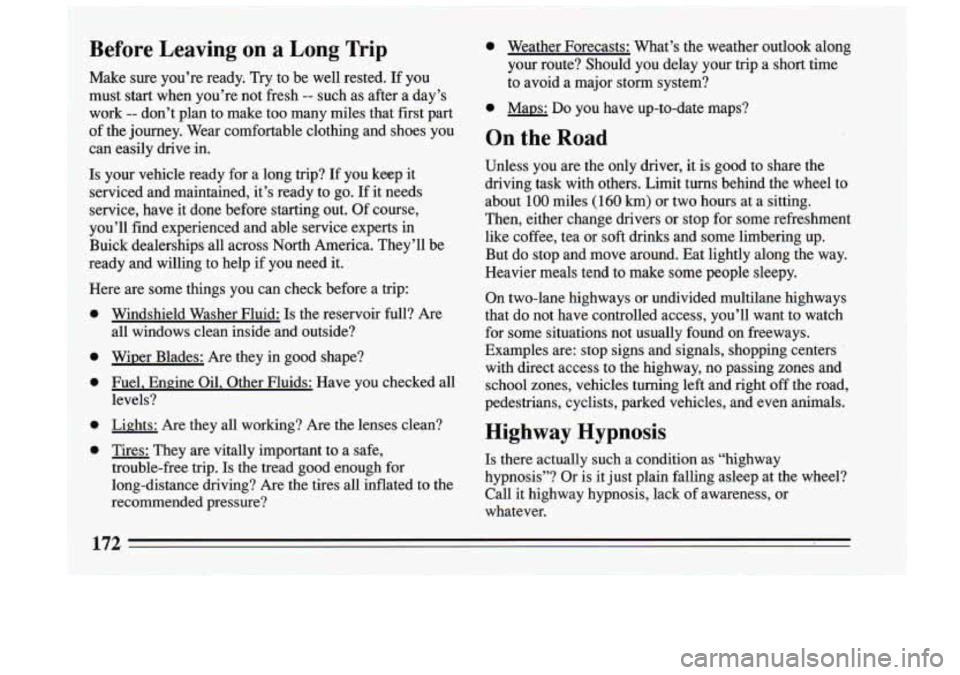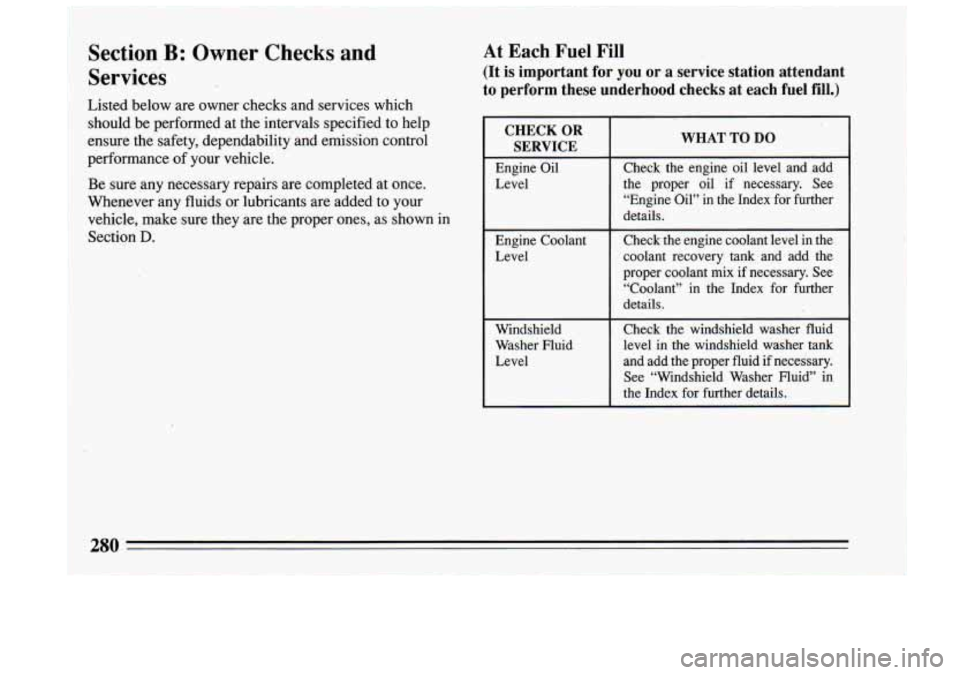Page 90 of 324

You can set the wiper speed for a long or short delay
between wipes. This can be very useful
in light rain or
snow. Turn the
band to choose the delay time. The
closer to
“LO,” the shorter the delay.
For steady wiping at low speed,
turn the band away
from
you to the “LO” position. For high speed wiping,
turn the band further, to “HI.” To stop the wipers, move
$he band to
“OFF.”
A CAUTION:
Damaged wiper blades may prevent you fro!..
seeing well enough to drive safely.
To avoid
damage, be sure to clear ice and snow from the
wiper blades before using them.
If they’re
frozen to the windshield, carefully loosen or
I
thaw them. If your blades do become damaged,
get new blades or blade inserts.
Heavy snow or ice can overload your wipers. A circuit
breaker will stop them until the motor cools. Clear away
,snow or ice to prevent an overload.
Windshield Washer
At the top of the multifunction lever there’s a paddle
with the word
“PUSH” on it. To spray washer fluid on
the windshield, just push the paddle for less than a
second. The washer will spray several times, then stop.
Unless they are already turned on, the wipers will
operate at low speed for several sweeps, then turn
off.
To get more fluid on the windshield, push and .hold the
paddle. Spraying will continue as long as the paddle is
held.
If this light comes on, it
means you’re low on
I washer fluid.
m
Page 91 of 324
A CAUTION:
Driving without washer fluid can be
dangerous.
A bad mud splash can block
your vision. You could
hit another vehicle
or
go off the road. Check your washer
fluid level often.
In freezing weather, don’t use your washer
until the windshield is warmed. Otherwise
the washer fluid can form ice on the
windshield, blocking your vision.
89
Page 174 of 324

~ Before Leaving on a
Long Trip 0 Weather Forecasts: What’s the weather outlook along
your route? Should
you delay your trip a short time
Make sure you’re ready. Try to be well rested. If you to avoid a major storm system?
must start when you’re not fresh
-- such as after a day’s
work
-- don’t plan to make too many miles that first part 0 Maps: Do you have up-to-date maps?
I
of the journey. Wear comfortable clothing and shoes you
can easily drive in. On the Road
Is your vehicle ready for a long trip? If you keep it
serviced and maintained, it’s ready to go. If it needs
service, have it done before starting out. Of course,
you’ll find experienced and able service experts in
Buick dealerships all across North America. They’ll be
ready and willing to help if
you need it.
Here are
some things you can check before a trip:
0 Windshield Washer Fluid: Is the reservoir full? Are
all windows clean inside and outside?
0 Wiper Blades: Are they in good shape!
0 Fuel, Engine Oil, Other Fluids: Have you checked all
levels?
0 Lights: Are they all working? Are the lenses clean?
0 Tires: They are vitally important to a safe,
trouble-free trip.
Is the tread good enough for
long-distance driving?
Are the tires all inflated to the
recommended pressure? Unless you
are the only driver, it is good to share
the
driving task with others. Limit turns behind the wheel to
about
100 miles (160 km) or two hours at a sitting.
Then, either change drivers or stop for some refreshment
like coffee, tea or soft drinks and some limbering up. But do stop and move around. Eat lightly along the way.
Heavier meals tend to make some people sleepy.
On two-lane highways or undivided multilane highways
that do not have controlled access, you’ll want to watch for some situations not usually found on freeways.
Examples are: stop signs and signals, shopping centers with direct access to the highway, no passing zones and school zones, vehicles turning left and right off the road,
pedestrians, cyclists, parked vehicles. td even animals.
Highway Hypnosis
Is there actually such a condition as “highway
hypnosis”?
Or is it just plain falling asleep at the wheel?
Call
it highway hypnosis, lack of awareness, or
whatever.
172
Page 181 of 324
h
Driving on Snow or Ice
Most of the time, those places where your tires meet the
road probably have good traction.
I
However, if there is snow or ice between your tires and
the road, you can have a very slippery situation. You’ll
have
a lot less traction or “grip” and will need to be very
careful.
Include
an ice scraper, a small brush or broom, a supply
of windshield washer fluid, a rag, some winter outer
clothing, a small shovel, a flashlight,
a red cloth, and a
couple of reflective warning triangles. And,
if you will
be driving under severe conditions, include a small bag
of sand, a piece of old carpet or a couple of burlap bags
to help provide traction. Be sure you properly secure
these items
in your vehicle.
What’s the worst time for this? “Wet ice.” Very cold snow or ice can be slick and hard to drive on. But wet ice \
can be even more trouble because it may offer the least
179
Page 225 of 324
A CAUTION:
An electric fan under the hood can start up and
injure you even when the engine is not running.
Keep hands, clothing and tools away from a---
underhood electric fan.
-
A CAUTION:
Things that burn can get on hot engine parts
and start a fire. These include liquids like
gasoline,
oil, coolant, brake fluid, windshield
washer and other fluids, and plastic or rubber.
You or others could be burned. Be careful not to
drop or spill things that will burn onto a hot
engine.
Before closing the hood, be sure all the filler caps are on
properly.
Then just pull the hood down and close
it firmly.
Page 237 of 324
Windshield Washer Fluid
To Add:
Open the cap labeled “WASHER FLUID ONLY.” Add
washer fluid until the bottle
is full.
P
Page 282 of 324

.Section B: Owner Checks and
Services At Each Fuel Fill
(It is important for you or a service station attendant
to perform these underhood checks at each fuel
fill.)
Listed below are owner checks and services which
should be performed at the intervals specified to help
ensure the safety, dependability and emission control
performance of your vehicle.
Be sure any necessary repairs are completed at once.
Whenever any fluids or lubricants are added to your
vehicle, make sure they are the proper ones, as shown in
Section
D.
CHECK OR
SERVICE
Engine Oil
Level
Engine Coolant
Level
Windshield
Washer Fluid
Level
WHAT TO DO
Check the engine oil level and add
the proper oil if necessary. See “Engine Oil” in the Index for further
details.
Check the engine coolant level in the
coolant recovery tank and add the
proper coolant mix if necessary. See “Coolant” in the Index for further
details.
Check the windshield washer fluid
level in the windshield washer tank
and add the proper fluid if necessary.
See “Windshield Washer Nuid”
in
the Index for further details. ~-~ ~- ~
280 .~
Page 288 of 324

I
USAGE I FLUID/LUBRICANT
Hydraulic Brake Delco Supreme ll@ Brake Fluid
System (GM Part No. 1052535) or
Parking Brake Chassis lubricant meeting Guides requirements
of NLGI Grade 2,
Category LB or GC-LB (GM Part
No. 1052497 or equivalent).
Power Steering GM Hydraulic Power Steering Fluid System
- (GM Part No. 1052884) or
equivalent
DOT-3 brake fluid.
equivalent.
Automatic
Transaxle
1
Key Lock
Cylinders
DEXFtON@ IIE Automatic
Transmission Fluid (GM Part No. 1234588 1) or equivalent.
Lubricate with Multi-Purpose
Lubricant (GM Part
No. 12345 120),
synthetic
SAE 5W-30 engine oil or
silicone lubricant (GM Part
No.
1052276 or 1052277).
Automatic Engine oil.
Transaxle Shift Linkage ~ ~~~
Chassis
Lubrication Chassis lubricant . meeting
requirements
of NLGI Grade 2,
Category LB
or GC-LB (GM Part
No. 1052497 or equivalent).
USAGE
Windshield
Washer Solvent
Hood Latch Assembly
a. Pivots and Spring
Anchor
b. Release Pawl
Hood and Door
Hinges, Fuel Door Hinge
Weatherstrips
FLUIDLUBRICANT
GM Optikleen@ Washer Solvent
(GM Part No. 1051515) or
equivalent.
a. Engine oil.
b. Chassis lubricant meeting
requirements
of NLGI Grade 2,
Category LB or GC-LB (GM Part
No. 1052497 or equivalent).
Engine oil or Lubriplate Lubricant (GM Part No. 1050109).
Dielectric Silicone Grease (GM Part
No. 12345579 or equivalent).
See “Specifications Chart” in the Index for
recommended replacement filters, valves and
spark
plugs.
286